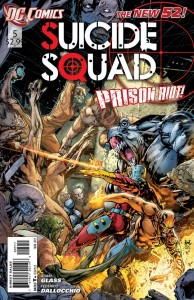 On a lot of levels, the reboot of Suicide Squad has been a hot mess. It started with a psychological torture tale, moved into a zombie story and then transitioned quickly into a prison break movie with almost no segues or fanfare… and that’s all in what’s supposed to be a single, cohesive, five-issue story arc. In many ways it’s a failure, but what’s saving it is two things: a total commitment to the primary characters on the part of writer Adam Glass… with the keyword there being “primary,” because the second saving grace is the apparent willingness to kill just about any character at any time.
On a lot of levels, the reboot of Suicide Squad has been a hot mess. It started with a psychological torture tale, moved into a zombie story and then transitioned quickly into a prison break movie with almost no segues or fanfare… and that’s all in what’s supposed to be a single, cohesive, five-issue story arc. In many ways it’s a failure, but what’s saving it is two things: a total commitment to the primary characters on the part of writer Adam Glass… with the keyword there being “primary,” because the second saving grace is the apparent willingness to kill just about any character at any time.
By the time this issue rolls around, what’s left of the Squad (We’ve lost one or two via simple escape, gunshot wound, the odd zombie attack and fatal viral infection… only some of which may have been passed on by Harley Quinn) is stuck behind bars, infected with something called the Rot Virus (Yeah, sounds like Harley) and charged with quelling a prison riot before the bombs they had stuck in their brain stems. So long story short, Glass is throwing everything at the wall to amp up the tension. Deadshot’s out of bullets. El Diablo might have to kill someone. Waller’s trapped two floors above the riot. And the tension works… for those characters.
When I was a kid, I developed a theory called “Murder She Wrote Logic,” which was borne out of (duh) Murder She Wrote. Whenever you watched that show, you didn’t need to look at the evidence or the logic or anything else; all you had to do was look at who was least likely to be the killer, and you knew that they were the perp. You can use the same logic on Suicide Squad: whichever characters are drawn in broad strokes are doomed. The aforementioned Deadshot, El Diablo and Amanda Waller are well drawn out with reasonably solid dialogue and characterization, so they make it. Others like Yo-Yo, and Voltaic in the first issue? Meat for the machine, man. It’s an area where the book falls down; yeah, Glass will kill members of the team – something you’d expect to see in a book called Suicide Squad – but you can pretty much call who’s dead the first time they speak. They might as well show Deadshot a picture of their grandkids and tell him how many days they have left until retirement.
The art by Federico Dallocchio serves the story reasonably well. It’s got kind of an abstract style; fine-lines but unlike a lot of 90s-inspired artists, not loaded with fine lines and cross hatching. The effect is interesting, leading to a lot of minute detail in some backgrounds and in Deadshot’s costume in particular (Lines which I guarantee will vex future artists worse than the webs on Spider-Man’s costume), while allowing for broader, more minimalist looks in a lot of facial expressions, wide shots and supporting characters. It makes for a strange mix to my eye, but his storytelling isn’t difficult to follow, and he captures the scope of a large-scale prison riot pretty well, but unfortunately not so well that, say, Bryan Hitch needs to start looking over his shoulder.
Suicide Squad is a hard book to pin down. The spastic, jumping from mission to mission nature of the plot so far feels a little ADD to me, but when I’m feeling charitable I could say that it gives the issues more of a one-and-done feel than many books of the New 52. Glass’s willingness to kill characters is somewhat refreshing for a superhero book. However, when you put that up against, say, The Walking Dead, where anyone can die and you care about the victims, the deaths in Suicide Squad feel more like shooting ducks in a gallery.
Honestly? I keep buying this because I like Deadshot, and Glass is writing him well… but not so well that I’ve stopped missing Secret Six. Generally, the book delivers, but it delivers like Dominos Pizza: it gets the job done, but you won’t write arias about it. At worst, it’s a pleasant diversion while you count the days to retirement… which, if Suicide Squad is any guide, you will surely reach if you show even a little bit of characterization.
 Podcast RSS Feed
Podcast RSS Feed iTunes
iTunes Google Play
Google Play Stitcher
Stitcher TuneIn Radio
TuneIn Radio Android
Android Miro Media Player
Miro Media Player Comics Podcast Network
Comics Podcast Network